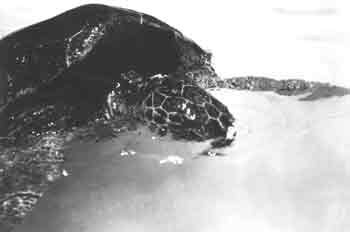Located near the northeastern corner of Costa
Rica, surrounded by rain forest on one side and Caribbean beach on the
other, is Tortuguero National Park, whose name means “The Place
of Turtles.”
Tortuguero’s 22-mile long beach is the main nesting area for Green
Turtles in the Caribbean. It is also the easiest place in the world to
view sea turtles.
Green Turtles mate and nest several times during a season. In mating,
an amorous male holds onto a female with the sharp hook on his front
flippers. If he can’t locate a female, he will improvise and substitute
anything that floats, whether it be a piece of driftwood, another male
turtle, or a skin diver.
An impregnated female will wait offshore until dark and then head for
the beach and a nesting site. During her crawl up the beach, noise or
lights will cause her to return to the safety of the sea. Once she has
begun digging her nest, however, nothing will distract her. She uses
her rear flippers to scoop out a hole about two-feet deep, deposits around
one hundred leathery, golf-ball-sized eggs, covers the nest, tamps down
the sand, and returns to the sea.
Many of the buried eggs are dug up by coatimundis, dogs, raccoons, and
even humans. The remaining eggs hatch in a couple of months. The baby
turtles use a temporary egg tooth to tear open their egg shell. It takes
the combined power of about 100 cooperating turtles to excavate the two
feet of sand which covers them.
The little turtles appear on the beach, usually before dawn, then scramble
for the water. On the way many are eaten by hungry crabs and birds. If
they do reach the water they stand a high chance of becoming dinner to
an eagerly waiting fish. Of the hundreds of thousands who race for the
sea, probably fewer than three percent survive. For the next half-century
the turtles live nomadic lives, migrating over vast distances of ocean.
After fifty years they reach sexual-maturity and return to the beach
where they were born, to mate, nest and produce another generation.
In addition to the Green turtles, Tortuguero is also a nesting place
for Leatherback, Hawksbill, Olive Ridley and Loggerhead turtles.
For would-be turtle watchers, the best time to see Green turtles is between
July and October. At this time you can also see Hawksbill and Olive Ridley
turtles. The Leatherback turtles return to Tortuguero during the months
of February through July. Of course there is no guarantee that you’ll
see the turtles at any time, as the weather, the tides, activity on the
beach, and other factors can discourage them from landing on any given
night.
With or without the turtles, Tortuguero is well worth visiting, as it
is a wonderful place to view countless animals and birds. Getting there
is half of the fun. There are no roads, just rivers and canals, so we
travel by boat. Birds fly overhead, monkeys and sloths hang in the trees,
and crocodiles rest along the river banks. Traveling up the jungle waterways
one can easily imagine himself as Humphrey Bogart or Katherine Hepburn
on
The African Queen.
Click Here for information on our Costa Rica Tours.



